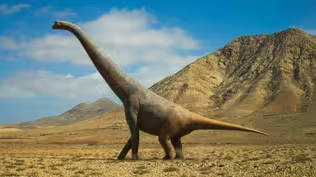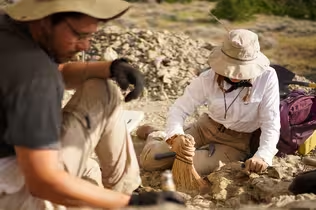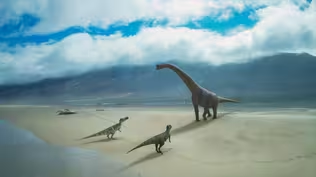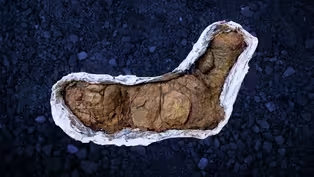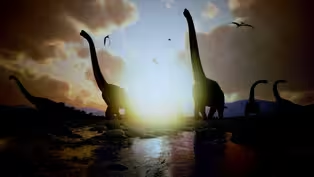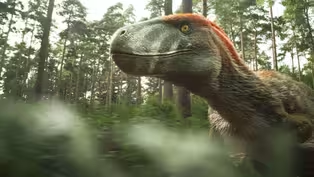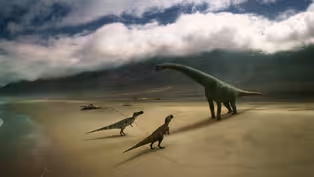
We Were Wrong About Spinosaurus
Special | 6m 36sVideo has Closed Captions
Millions of years ago, dinosaurs ruled the Earth. But underwater it was a totally different world.
Marine reptiles like plesiosaurs ruled beneath the waves - to such an extent that no aquatic dinosaur has ever been discovered. But that could all be about to change. Palaeontologist Nizar Ibrahim is building a remarkable case that could upend more than a century of conventional scientific wisdom.
Problems playing video? | Closed Captioning Feedback
Problems playing video? | Closed Captioning Feedback
Narrator: Shane C. Campbell-Staton With Thanks: University of Casablanca, University of Portsmouth, Morocco Dig Team Digital Producer & Director: Mark Atwill Digital Producer: Tom Heyden Post Production: Envy Post Production...

We Were Wrong About Spinosaurus
Special | 6m 36sVideo has Closed Captions
Marine reptiles like plesiosaurs ruled beneath the waves - to such an extent that no aquatic dinosaur has ever been discovered. But that could all be about to change. Palaeontologist Nizar Ibrahim is building a remarkable case that could upend more than a century of conventional scientific wisdom.
Problems playing video? | Closed Captioning Feedback
How to Watch Walking with Dinosaurs
Walking with Dinosaurs is available to stream on pbs.org and the free PBS App, available on iPhone, Apple TV, Android TV, Android smartphones, Amazon Fire TV, Amazon Fire Tablet, Roku, Samsung Smart TV, and Vizio.
Providing Support for PBS.org
Learn Moreabout PBS online sponsorshipMore from This Collection
Check out our 12 digital exclusives from our series Walking with Dinosaurs with BBC.
When Dinosaurs Ruled the Arctic Circle
Video has Closed Captions
Very few dinosaurs made it as far North as the Arctic Circle...except for two. (5m 52s)
Were Dinosaur Brains Designed For Combat?
Video has Closed Captions
Did Pachyrhinosaurus bones always gather in such great numbers? (5m 42s)
How We Solve Jurassic Mysteries from One Bizarre Fossil
Video has Closed Captions
Would you lick a 65-million-year old dinosaur poop? (5m 19s)
How Walking with Dinosaurs Created the Most Accurate Dinos Ever
Video has Closed Captions
Join the team behind the scenes! (6m 32s)
How to Find a Dinosaur that Hollywood Dreamed Up
Video has Closed Captions
What would make a Utahraptor so much larger than other raptor species? (5m 50s)
How the Walking with Dinosaurs Team Brought a Dinosaur Back to Life
Video has Closed Captions
The Walking With Dinosaurs team reveal how they created the Spinosaurus. (5m 50s)
How Extreme Weather Is Revealing — And Destroying — Dinosaur Fossils
Video has Closed Captions
Imagine finding a rare fossil that you’ve been desperate to find - only for it to be put at risk. (5m 59s)
How an Evolutionary Arms Race Created Bizarre Dino Designs
Video has Closed Captions
It’s grudge match time. Except that this one took place over millions of years. (5m 32s)
The Dinosaurs that Could Cross the Atlantic
Video has Closed Captions
How did dinosaur fossils get there? (5m 42s)
Did Dinosaurs Abandon Their Young to Help Them Survive?
Video has Closed Captions
In late Cretaceous Alberta, many apex predators roamed free, so how did the prey survive? (5m 45s)
Did a Meteor Kill All the Dinosaurs?
Video has Closed Captions
Did the asteroid kill the T. rex and Triceratops? (5m 42s)
Providing Support for PBS.org
Learn Moreabout PBS online sponsorship[grumbles] -[Narrator] Millions of years ago, the land was dominated by dinosaurs.
But it's long been thought that this was the boundary of their kingdom.
[water gurgling] Underwater, plesiosaurs and ichthyosaurs reigned supreme.
Often mistaken for dinosaurs, these were actually marine reptiles.
No trace of a waterborne dinosaur has ever been found.
Until now.
New evidence is telling a different story about what went on beneath the waves.
Of what would be the world's first aquatic dinosaur.
And that story starts in the desert.
[drums pounding] While digging in the Moroccan Sahara, paleontologist Nizar Ibrahim and his team unearthed something amazing.
The gigantic bones of a Spinosaurus.
An 8 ton, 39-foot-long apex predator.
-[Nizar Ibrahim] So, a Spinosaurus is several meters longer than T. Rex, so it is the largest predatory dinosaur known.
-[Narrator] It was the most complete Spinosaurus skeleton ever found.
For more than 100 years, Spinosaurus has been known as a ferocious terrestrial predator.
But as he was reassembling it, Nizar noticed something strange.
-[Nizar] This dinosaur has water loving written all over it.
We realized that this was really a river monster.
-[Narrator] It's a potentially game changing hypothesis.
This would make it the first ever aquatic dinosaur, overturning more than a century of scientific thinking.
But no new theory is without its skeptics.
Nizar knows he's going to have to prove it.
So back at his Portsmouth University lab, he went to work.
Spinosaurus' most striking feature was a long paddle-like tail.
-[Nizar] When we first looked at those tail bones we thought well, "That looks like a propulsive structure."
-[Narrator] But lots of dinosaurs have powerful tails.
The question was whether this one could propel 8 tons of dinosaur.
Could Spinosaurus really swim and hunt underwater?
[water gurgles] To find out, he teamed up with engineers from Harvard University.
They designed a special tank to test Spinosaurus' prowess in the pool.
-We built a robotic Spinosaurus tail in a tank to compare the performance of a Spinosaurus tail fin to the tails of other predatory dinosaurs.
-[Narrator] Spinosaurus' tail was almost three times better at pushing through the water than any other dinosaur tested.
It was comparable to the powerful tail of a crocodile.
To Nizar, this was the first evidence that Spinosaurus could easily hunt fish underwater.
But the tail wasn't the only clue that this was a specialist fisher.
Using the bones, they created an accurate model of Spinosaurus' skull.
And it had a very unusual jaw that Nizar thinks was perfect for catching fish.
-That the opening here can actually be widened to basically deal with the large, big, chunky fish that Spinosaurus would have fed on.
-[Narrator] Even its unusual teeth looked like fishing tools.
-These are the conical teeth of a fish eater.
-[Narrator] Meat eaters tend to have thinner, flatter teeth for tearing their food apart.
Conical teeth are better for spearing and hanging on to slippery fish.
Thousands of these teeth have been discovered in the beds of the ancient rivers where Spinosaurus lived.
To Nizar, it's a big clue it spent most of its time in the water.
-[Nizar] Dinosaurs will go through a lot of teeth throughout their lifetime.
Spinosaurus will shed teeth, and you know, new replacement teeth grow.
But the only way you can get this abundance of Spinosaurus teeth is really by having an animal that spends almost all of its time inside the river.
-[Narrator] But there's another piece to this puzzle.
If Spinosaurus is truly the first aquatic dinosaur, even its brain will be adapted to life in the water.
And Nizar can figure out its structure thanks to an important skull bone, the brain case.
-[Nizar] The brain case is essentially the back of the skull, the part that encloses the brain.
If we look at the brain case, we can reconstruct the actual shape of the brain that was inside.
-[Narrator] Using the x-rays of a CT scanner, Nizar can look inside these fragments and recreate a detailed 3D image of the brain.
And it's already given him one big clue.
-[Nizar] But they look pretty good, right?
-[Man] Yeah, yeah, yeah.
These look great.
-[Narrator] It looks like major nerves ran from the brain to openings at the far end of the upper jaw.
-[Nizar] Crocs and alligators have openings at the tip of their snout.
And these openings house pressure receptors.
-[Narrator] These sensors make the snouts super sensitive to changes of pressure underwater, such as the movement of fish.
[water gurgling] In the murky waters that Spinosaurus called home, this would have allowed it to catch prey based on the slightest vibrations.
A key adaptation if you spend most of your time hunting in water.
-And it's quite likely that Spinosaurus would have taken full advantage of, of this.
-[Narrator] The evidence is mounting up.
But Nizar knows to upend a century's worth of conventional wisdom, he'll need to build a watertight case that Spinosaurus left behind a life on land for the water.
Because if he's right, it could change much of what we thought we knew about this dinosaur.
[gentle music]

- Science and Nature

Explore scientific discoveries on television's most acclaimed science documentary series.

- Science and Nature

Capturing the splendor of the natural world, from the African plains to the Antarctic ice.












Support for PBS provided by:
Narrator: Shane C. Campbell-Staton With Thanks: University of Casablanca, University of Portsmouth, Morocco Dig Team Digital Producer & Director: Mark Atwill Digital Producer: Tom Heyden Post Production: Envy Post Production...

